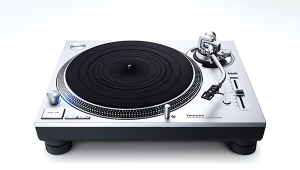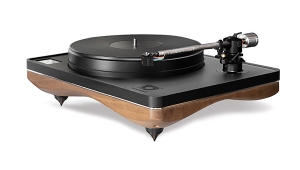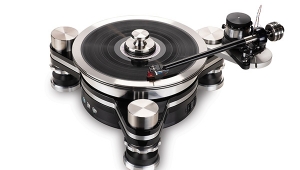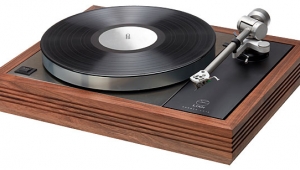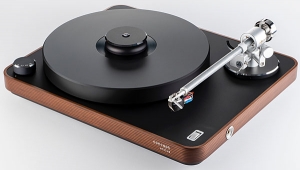| Columns Retired Columns & Blogs |
Oracle Delphi turntable
The Oracle Delphi Mk.II ($1250) is both a turntable and work of art. It is a visually stunning product, retaining a level of styling that, in my view, has never been equalled by any other audio component. It also adds enough sonic improvements to the original Delphi that it ranks close to the VPI HW-19, and is superior, in naturalness of sound quality, to the SOTA Star Sapphire.

These improvements include much easier setup procedures (although far more fuss and bother than the SOTAs and VPI), and a better motor, suspension, and top plate. Earlier Delphi motors were noisy or had quality-control problems. Some had audible long-term wow. The DC motor on the Delphi II is now a Pabst motor, the motor first used on the $2500 Oracle Premiere; its drive is smoothed by a capacitor bank, and the motor has a 1 lb flywheel carefully balanced at the factory; the inertia provides better speed accuracy.
The Delphi II uses a slightly thicker base, and has a new spring suspension system which does a better job of preventing acoustic breakthrough. It also uses a new molybdenum disulphide oil. I can't advise you on the merits of each of these features, but the overall result is significant. Anyone who, in the past, found the Delphi to have wow and flutter problems, or vulnerability to furniture vibration or floorboard movement, will find it has improved significantly. The SOTA and VPI are better, but not by much.
Audiophiles who change tonearms can now select the precise set of springs to tune the turntable to a particular tonearm, and the instructions for doing so are now very well-written indeed. Audiophiles will be equally pleased by the combined cartridge alignment protractor and stroboscope for setting turntable speed, which can be set precisely at the back of the turntable.
As for the sound, the only real weakness lies in a loss of deep bass, and a problem with record damping: the Delphi II cannot damp the record without losing a slight amount of life and dynamics. Like most freely floating-suspension turntables I have tested, the Oracle tends to reduce bass energy in comparison with other designs. Unlike the Linn Sondek, however, it also seems to lose a slight amount of natural midrange life or dynamics. This can be minimized by use of the manufacturer's metal tonearm mounting plate, clamping it as hard as possible to the turntable frame. The tonearm mounting should, however, be filled with a 1/8"–1/4" layer of Mortite under the plate. Without such damping, the metal plate tends to rob the sound of some of the sweetness provided by the acrylic tonearm mounting plate (which cannot be rigidly clamped to the turntable frame).
Otherwise, the Delphi II provides an exceptionally neutral and musical sound. The speed regulation and stability problems common to many belt-driven turntables are minimal, and the Delphi II provides consistently more musical low-level harmonic and transient information from the midrange up than most competing designs. The soundstage and imaging are stable and musically convincing, though a bit lacking in depth. The dynamics and musical life may not equal the very best, but they have excellent transparency, with little of the hardness or extra record noise common to most competing designs.
In fact, the slight loss of dynamics may have its advantages. The Oracle Delphi II is very easy and pleasurable to listen to because of its sweet and unfatiguing upper midrange and highs. Its midrange coherence—the ability to provide a consistently musical and convincing sound over very long periods of time—rivals any turntable at any price.
In short, the Oracle Delphi II is the kind of turntable that makes many audiophiles feel that analog disc is still the most pleasurable source of music in the home. It does impose some tradeoffs between exceptional sweetness in the upper midrange and upper octaves, and a reduction of energy in the lower bass, but none of the competition is free of tradeoffs. The Delphi II can give you years of musical pleasure and excitement.
As for setup and system integration, a further improvement in the bass is possible with virtually all turntables by replacing the standard feet with spiked feet or Tiptoes. These will "fix" the turntable firmly to cabinet or shelf. This seems to consistently improve the clarity and "life" of the bass and lower midrange.
The SOTA, VPI, and Delphi also work synergistically with the new air-bearing arms. The Eminent Technology Two, for example, provided outstanding performance with all three turntables (there is a special mounting kit for the Oracle). In fact, I'd urge you to audition this combination. I've not had the opportunity to test the new SME V or the latest Goldmund arms in my system, but the few people I know who've experimented have all felt the Eminent Technology to be at least as good, and $700 to $2200 cheaper.
More generally, tonearm choice is at least as important as turntable choice. The tonearm often has more immediate effect on sound quality than the relatively small sonic differences that emerge between turntables like the VPI, SOTA, and Oracle. A tonearm produces more shifts in the midrange in terms of speed, resonant coloration, and soundstage characteristics. Tonearm choice can also be critical in terms of bass performance—few tonearms can really reproduce the deep bass.
The VPI, SOTAs, and Oracle have relatively low vulnerability to acoustic breakthrough, but I have heard slight improvements in transparency and bass by moving them a few inches further away from the wall or by shifting them over the surface of vibrating furniture. Placement in an area away from standing waves or high bass energy nodes will improve their sound more significantly.—Anthony H. Cordesman
- Log in or register to post comments
